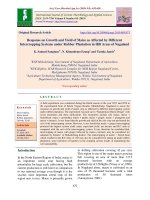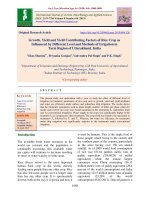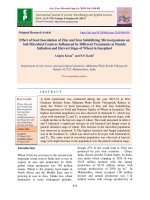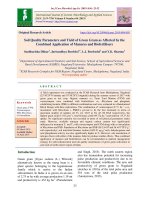Residual soil fertility and yield in pigeon pea, pearl millet and green gram as influenced by intercropping systems under western Haryana condition
Bạn đang xem bản rút gọn của tài liệu. Xem và tải ngay bản đầy đủ của tài liệu tại đây (198.86 KB, 7 trang )
Int.J.Curr.Microbiol.App.Sci (2017) 6(3): 2233-2239
International Journal of Current Microbiology and Applied Sciences
ISSN: 2319-7706 Volume 6 Number 3 (2017) pp. 2233-2239
Journal homepage:
Original Research Article
/>
Residual Soil Fertility and Yield in Pigeon Pea, Pearl Millet and Green Gram
As Influenced by Intercropping Systems Under Western Haryana Condition
Niranjan Kumar Barod, Satish Kumar and Mohammad Irfan*
Department of Agronomy, CCS HAU Hisar-125004, India
*Corresponding author
ABSTRACT
Keywords
Pigeon pea, Pearl
millet, Green gram,
Intercropping
systems.
Article Info
Accepted:
24 February 2017
Available Online:
10 March 2017
The investigation entitled “Response of nitrogen application in wheat succeeding pigeon
pea intercropped with pearl millet and green gram” was carried out at Agronomy research
farm of Chaudhary Charan Singh Haryana Agricultural University, Hisar during kharif and
rabi season 2011-12 and 2012-13. It comprised of 12 treatments were replicated thrice in
randomized block design. Based on aforesaid investigation it was found that intercropping
systems influenced the grain, straw and biological yield significantly were highest in sole
crop i.e. pigeon pea (1983 and 2059, 2059 and 5947 and 7777 and 8006 kg ha-1), pearl
millet (2122 and 2218, 5999 and 6200 and 8121 and 8418 kg ha-1) and green gram (1319
and 1402, 3925 and 4175 and 5244 and 5576 kg ha -1) respectively during 2011 and 2012
crop seasons. Highest N availability was recorded under green gram sole which did not
differ significantly from various intercropping treatments except pearl millet sole.
Significantly lowest N availability was recorded under pearl millet sole during 2011 and
2012 crop seasons.
Introduction
Pigeon pea (Cajanus cajan L.) also known as
arhar, tur or red gram is one of the most
important kharif pulse crop cultivated in
India. It is next to only chickpea in area and
production among all pulse crop grown in
India. Pigeon pea grown as a sole crop is not
economically viable because of its slow initial
growth rate, low productivity and longer
duration. Because of slow growth the crops
face a lot of competition with weeds and the
inter-row space was not utilized properly
(Velaytham et al., 2003). In order to have
better utilization of the resources, growing a
short duration intercrop like green gram and
pearl millet between the pigeon pea rows
helps in utilization of available resources
without affecting its productivity, short
duration and short statured crops like pearl
millets and green gram and would prove to be
a viable intercropping system. Intercropping
with short duration pulses like green gram and
cereals like pear millet in pigeon pea enhance
total productivity (Sharma et al., 1995). Green
gram (Vigna radiata L.) is also an important
kharif pulse crop of India. It is an excellent
source of high quality protein. As short
duration crop it fit well in various multiple
and intercropping systems (Pujari and
Sheelvantar, 2002). Pearl millet (Pennisetum
glaucum L.) is one of the most important rain
fed crop of India. Its grains possess higher
protein content with higher level of essential
amino acids. The inclusion of pearl millet
with pigeon pea will definitely ensure the
2233
Int.J.Curr.Microbiol.App.Sci (2017) 6(3): 2233-2239
fulfillment of dietary requirement and
enhanced productivity of crops per unit area
per unit time (Anonymous, 2004).
Intercropping is an age-old practice being
followed by subsistence farmers to achieve
their domestic needs. The main advantage of
the intercropping is that the component crops
are able to use the growth resources more
efficiently (Willey, 1979). Nitrogen needs of
cereals intercropped with legumes are
reported to be less than for sole cropping due
to transfer of some of the fixed nitrogen by
legumes to the associated cereals during the
growing season (Willey, 1979). Intercropping
of legumes with pearl millet has been reported
to be more stable and dependable than sole
cropping (Patel et al., 1998). In intercropping
systems, selection of compatible crops with
different growth pattern and their suitable
planting geometries are very important
because, it helps to minimize inter and intra
specific competitions for resources. A lot of
work has been done on nutrient management
in pigeon pea and wheat crop alone. However,
very less information is available on the effect
of pearl millet, green gram intercropping in
pigeon pea. Therefore, in view of the above,
the present investigation was planted.
Materials and Methods
The experiment was conducted at the
Agronomy Research Farm, CCS Haryana
Agricultural University, Hisar during 2011
and 2012. It is situated at 29o10’ N latitude,
75o46’ E longitude and at an altitude of 215.2
meters above mean sea level, the experiment
was laid out in randomized block design in
Kharif. The kharif crops pigeon was as sole
and in combination with pearl millet and
green gram at different spacing and rows in
the kharif season during 2011 and 2012
resulting in 12 treatments. In the pigeon pea
(Manak), pearl millet (HHB-67 Improved)
and green gram (Basanti) was sown on 17th
June during the year 2011 and 18th June
during the year 2012. The soil of the
experimental unit was sandy loam and the soil
pH was 7.8 and 7.9, while the EC was 0.39
and 0.40 dSm-1 during 2011 and 2012,
respectively. The organic carbon of the soil
was 0.41 and 0.40 per cent during both the
years of study. The soils of the experiential
field was sandy loam in texture, poor organic
matter (0.41) and low in available nitrogen
(162 kg ha-1), medium in available
phosphorus (25 kg ha-1) and high in available
potassium (305 kg ha-1) and slightly alkaline
in reaction.
Results and Discussion
Yields of pigeon pea
The different intercropping systems produce
significant variation in yield during both the
years of study. Among the different
intercropping systems, grain, straw and
biological yield of pigeon pea varied
significantly with the sole pigeon pea (Table
1). Pigeon pea planted as paired row (30:60
cm) produced statistically similar grain yield
as compared to pigeon pea sole planted at 45
cm row spacing. Paired row sowing of pigeon
pea produced 8.24 and 7.74 per cent higher
grain yield as compared to pigeon pea at 45
cm row spacing during 2011 and 2012,
respectively. Under different intercropping
systems the higher grain yield of pigeon pea
was recorded from pigeon pea (75 cm) +
green gram (1:2) systems however; it was at
par with the intercropping systems pigeon pea
(75 cm) + green gram (1:1). It might be due to
synergistic effect of component crop. Similar
result was obtained by Kumar et al., 2005,
and Kumar et al., 2012. The different
intercropping systems failed to produce
significant variation in harvest index of
pigeon pea as compared to sole crop of
pigeon pea.
2234
Int.J.Curr.Microbiol.App.Sci (2017) 6(3): 2233-2239
Table.1 Effect of intercropping systems on yield of pigeon pea
Yield (kg ha-1)
Treatment
Grain yield
Straw yield
Biological yield
2011
2012
2011
2012
2011
2012
Pigeon pea sole (45 cm)
1832
1911
5373
5488
7105
7399
Pigeon pea – Paired row (30: 60 cm)
1983
2059
2059
5947
7777
8006
Pigeon pea (75 cm) + Pearlmillet
(1:1)
1415
1593
4496
4711
5911
6304
Pigeon pea (75 cm) + Pearlmillet
(1:2)
1384
1563
4449
4550
5833
6113
Pigeon pea (75 cm) + Green gram
(1:1)
1530
1600
4416
4571
5946
6171
Pigeon pea (75 cm) + Green gram
(1:2)
1611
1684
4625
4826
6236
6510
Pigeon pea (90 cm) + Pearlmillet
(1:1)
1329
1473
4131
4280
5460
5753
Pigeon pea (90 cm) + Pearlmillet
(1:2)
1296
1406
3959
4095
5255
5501
Pigeon pea (90 cm) + Green gram
(1:1)
1332
1503
4236
4335
5568
5838
Pigeon pea (90 cm) + Green gram
(1:2)
1369
1540
4523
4458
5892
5998
SEm±
73
66
92
102
107
126
L.S.D.(p=0.5)
222
197
268
293
312
364
2235
Int.J.Curr.Microbiol.App.Sci (2017) 6(3): 2233-2239
Table.2 Effect of intercropping systems on yield of pearl millet and green gram
Treatment
Pearl millet sole (45cm)
Green gram sole (30 cm)
Pigeon pea (75 cm) + Pearlmillet
(1:1)
Pigeon pea (75 cm) + Pearlmillet
(1:2)
Pigeon pea (75 cm) + Green gram
(1:1)
Pigeon pea (75 cm) + Green gram
(1:2)
Pigeon pea (90 cm) + Pearlmillet
(1:1)
Pigeon pea (90 cm) + Pearlmillet
(1:2)
Pigeon pea (90 cm) + Green gram
(1:1)
Pigeon pea (90 cm) + Green gram
(1:2)
SEm±
L.S.D.(p=0.5)
Pearlmillet (kg ha-1)
Biological
Grain yield Stover yield
yield
2011 2012 2011 2012 2011 2012
2122 2218 5999 6200 8121 8418
1526
1618
4319
4560
5846 6178
1680
1776
4709
4903
6389 6679
1413
1506
3933
4178
5346 5684
1575
1667
4407
4662
5983 6329
83
277
71
237
295
979
301
999
2236
408 414
1352 1373
Green gram (kg ha-1)
2011
2012
2011
2012
Biological
yield
2011 2012
1319
1402
3925
4175
5244
5576
692
789
2192
2502
2884
3291
853
946
2668
2957
3520
3903
622
714
1973
2264
2594
2977
774
867
2281
2560
3055
3427
51
147
47
139
68
201
64
189
56
166
121
357
Grain yield
Stover yield
Int.J.Curr.Microbiol.App.Sci (2017) 6(3): 2233-2239
Table.3 Effect of intercropping systems on soil fertility status after harvesting of kharif crops
Available N (kg ha-1)
Available P2O5 (kg ha-1)
Available K2O (kg ha-1)
Treatment
2011
2012
2011
2012
2011
2012
Pigeon pea sole (45cm)
186
187
18.04
19.45
301.95
302.59
Pearl millet (45cm)
172
171
14.28
15.10
296.60
298.40
Green gram sole (30cm)
190
192
19.10
20.25
304.54
305.44
Pigeon pea - paired row (30:60 cm)
186
188
17.29
18.19
301.71
301.67
Pigeon pea (75cm) + Pearl millet (1:1)
175
176
16.17
16.78
299.88
299.92
Pigeon pea (75cm) + Pearl millet (1:2)
173
175
16.06
16.72
299.22
299.85
Pigeon pea (75cm) + Green gram (1:1)
187
188
18.07
18.71
302.31
302.73
Pigeon pea (75cm) + Green gram (1:2)
188
189
18.44
19.13
303.40
303.35
Pigeon pea (90cm) + Pearl millet (1:1)
177
179
15.31
16.03
298.40
299.62
Pigeon pea (90cm) + Pearl millet (1:2)
176
178
15.27
15.97
297.70
298.41
Pigeon pea (90cm) + Green gram (1:1)
183
184
16.30
16.87
300.59
301.12
Pigeon pea (90cm) + Green gram (1:2)
185
187
16.84
17.13
301.71
301.49
SEm+
2.61
2.94
1.38
1.19
2.72
2.83
L.S.D.(p=0.5)
7.71
8.69
NS
NS
NS
NS
2237
Int.J.Curr.Microbiol.App.Sci (2017) 6(3): 2233-2239
Yields of pearl millet
Effect on available Nutrients (N, P and K)
in soil after harvest of kharif crop
Pearl millet sole crop produced significantly
higher grains, straw and biological yield as
compared to different intercropping systems.
It was 26.31 and 34.73 per cent higher as
compared to pigeon pea (75 cm) + pearl
millet (1:2) and pigeon pea (90 cm) + pearl
millet (1:2)
Irrespective of pigeon pea row spacing two
rows of intercrop produced higher grain straw
and biological yield as compared to single
row though the difference were nonsignificant among them during both year
(Table 2). The grain and straw yield was
recorded to be significantly higher in sole
system over intercropping systems which
might be due to higher plant population of
pearl millet in sole crop as compared to
intercropping systems. Lower yield of pearl
millet was recorded from other intercropping
treatments because of less number of plants
per hectare. Choudhary and Gautam, 2006
and Kuri et al., 2012 also reported similar
results.
After the harvest of the experimental crop in
each year, available nitrogen in soil increased
under various treatments involving sole,
intercropping of grain legumes and pearl
millet except pearl millet sole. Thus,
improvement in available N was noted under
various crop system involving grain legumes
either in sole or intercropping systems. This
might be ascribed to the fact that grain
legume improve the available nitrogen
content of the soil through the process of
symbiotic nitrogen fixation (Heldt, 1987).
Such effects were, however, not apparent in
respect to P and K after the harvest of
experimental crop in individual year (Table
3). Similar result was found by Kujur et al.,
2010.
Based on the two year (2011-12 and 2012-13)
field experimentation the study can be
concluded as: Among different intercropping
systems tested during kharif season, pigeon
pea 75 cm intercropped with two row of green
gram was found most suitable.
Yields of green gram
References
In case of green gram the grain, straw and
biological yield was recorded maximum in
sole crop, which was due to more number of
plants and better yield attributes of the crop in
one side and better interception of sunlight
and more photosynthesis resulting into more
production
of
photosynthates
and
translocation to the economic part on the
other side Kumar et al., 2005, and Sharma et
al., 2010 also reported similar result (Table
2). The higher yield of green gram in pigeon
pea (75 cm) + green gram (1:2) systems was
because of more number of rows of green
gram and reduced competition between and
within crop plants due to more availability of
space (Bishnoi et al., 1987).
Anonymous 2004. Sustaining nutritional
security. In: Survey of Indian
Agriculture, pp. 37-38.
Bishnoi, K.C., Singh, B. and Singh, A. 1987.
Studies on compatibility of green gram
and blackgram cultivars in pigeon pea
based intercropping systems. Indian J.
Agron. 32: 127-129.
Choudhary, R.S. and Gautam, R.C. 2006.
Influence of cropping systems and
nutrient management on nutrient
uptake,
protein
content,
yield,
productivity and net returns of pearl
millet (Pennisetum glaucum). Annals of
Agric. Res. New Series, 27(4): 302-305.
Heldt, H.W. 1987. Plant biochemistry and
2238
Int.J.Curr.Microbiol.App.Sci (2017) 6(3): 2233-2239
molecular biology. Oxford University
Press. pp: 277.
Kujur, S. Ahmad, S. Srivastava, G.P. and
Singh, C.S. 2010. Performance of
pigeon pea (Cajanus cajan L.)
intercropping as influenced by row ratio
and duration of finger millet (Elusine
coracana) cultivars. Indian J. Agron.
55(3): 209-214.
Kumar, P., Rana, K.S. and Rana, D.S. 2012.
Effect of planting systems and
phosphorus with bio-fertilizers on the
performance of sole and intercropped
pigeon pea (Cajanus cajan L.) under
rainfed conditions. Indian J. Agron.
57(2): 127-132.
Kumar, S., Singh, R.C. and Kadian, V.S.
2005. Compatibility of pigeon pea and
green gram intercropping systems in
relation to row ratio and row spacing.
Legume Res., 28(3): 213-215.
Kuri, B.R., Yadav, R.S. and Kumawat, A.
2012. Evaluation of pearl millet
(Pennisetum glaucum) and mothbean
(Vigna acconitifolia) intercropping
systems in hyper-arid partially irrigated
north-western plain zones. Indian J.
Agric. Sci., 82(11): 993-996.
Patel, M.R., Kalyanasundaram, N.K., Patel,
I.S., Patel, J.M., Patel, S.I., Patel, B.M.
and Patil, R.G. 1998. Effect of additive
and replacement series in intercropping
system with pearl millet. Annals of Arid
Zone, 37: 69-74.
Pujari, B.T. and Sheelvantar, M.N. 2002. Dry
matter accumulation in plant parts of
green gram (Vigna radiata) as
influenced by cropping system, row
proportion and green gram population
levels. Indian J. Agric. Res., 36: 156161.
Sharma, A., Rathod, P.S. and. Basavaraj, K.
2010. Agronomic management of
pigeon pea (Cajanus cajan L.) based
intercropping systems for improving
productivity under rainfed conditions.
Kamataka J. Agric. Sci., 23(4): 570574.
Sharma, N.N., Sharma, D. and Paul, S.R.
1995. Intercropping of green gram
(Vigna radiata), blackgram (Vigna
mungo) and sesamum (Sesamum
indicum) and pigeon pea (Cajanus
cajan L.) under different seeding
methods. Indian J. Agron., 40: 386-387.
Velayutham, A., Kalpana, R. and Sankaran,
N. 2003. Effect of fertilizer levels on
pigeon
pea
and
green
gram
intercropping systems. Madras Agric.
J., 90(10): 607-610.
Willey, R.W. 1979. Intercropping, importance
and research need competition and yield
advantages. Field Crops, 32(1): 1-10.
How to cite this article:
Niranjan Kumar Barod, Satish Kumar and Mohammad Irfan. 2017. Residual Soil Fertility and
Yield in Pigeon Pea, Pearl Millet and Green Gram As Influenced by Intercropping Systems
Under Western Haryana Condition. Int.J.Curr.Microbiol.App.Sci. 6(3): 2233-2239.
doi: />
2239







![Growth and yield of Ashwagandha [Withania somnifera (L.)] as influenced by different intercropping system in Kymore plateau of Madhya Pradesh](https://media.store123doc.com/images/document/2020_01/09/medium_vsb1578562778.jpg)

